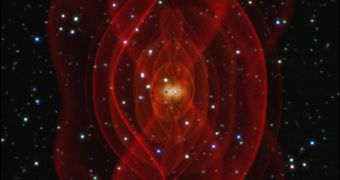There are quite a few large laser interferometers in the world today, including the two LIGO detectors in the US, specially constructed to test the existence of gravitational waves, distortions in the fabric of space-time determined by gravitational interactions between very massive cosmic bodies, such as the merging of black holes of neutron stars. However, with the current sensitivity of these detectors, gravitational waves would probably never be directly detected.
Australian and US physicists believe that one way to enhance the sensitivity of these laser interferometers would be to light in a 'squeezed state'. During testing, such a prototype device revealed a 44 percent sensitivity improvement. In just a few years, gravitational wave detectors using the quantum properties of light could reach a 300 percent sensitivity, allowing scientists to search for gravitational waves in a much larger volume of space than previously possible.
Gravitational wave detectors are generally based on light interferometer devices. Light travels through two arms placed at a 90-degree angle in relation to each other, each measuring several kilometers in length. A laser beam is split and sent through both arms of the interferometer and bounced on highly reflective mirrors before recombining the beam in order to send it to the photodetector. Gravitational waves traveling through space, assuming that they even exist in the first place, should be able to exert some influence on the relative positions of the mirrors. When this happens, the interference pattern between the two laser beams changes and is detected by the photodetector.
Small variations
The problem is that even the most powerful gravitational waves produced by a merging between two distant black holes would only generate a distance variation in the relative position of the mirrors several thousand times smaller than the diameter on an atom. Due to this reason only, the data collected by the two LIGO detectors cannot be filtered from background noise, in order to reveal if a gravitational wave passed through the detector.
The new gravitational wave detectors and the upgrades to the old ones should be completed by 2010. By using light in a squeezed state, their sensitivity would depend only on the quantum properties of the laser beam.
Quantum physics laws introduce a great deal of uncertainty, but physicist may use this disadvantage to minimize the background noise. For example, by increasing the amplitude of light in a squeezed state, phase uncertainties become smaller, thus increasing the sensitivity of the interferometer.
Squeezed light
Basically, bringing light into a squeezed state requires the passing of an infrared laser beam through two non-linear optical materials, in which the refraction index is in direct relation to the amplitude of light. The infrared source is based on a neodymium-doped yttrium aluminum garnet laser, able to create a continuous beam of light with a wavelength of 1064 nanometers. The infrared beam is filtered through a 'second harmonic generator', which creates a 532 nanometers laser beam. This laser beam is then used to produce two laser beams on 1064 nanometers with the help of an 'optical parametric oscillator', thus bringing light into a squeezed state.
Although with this technique the sensitivity of the LIGO detectors could be enhanced by up to 300 percent, they would only require 200 percent improvement in order to detect gravitational waves in a volume of space eight times greater than currently possible.

 14 DAY TRIAL //
14 DAY TRIAL //